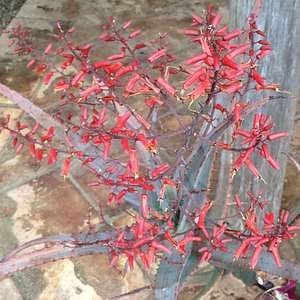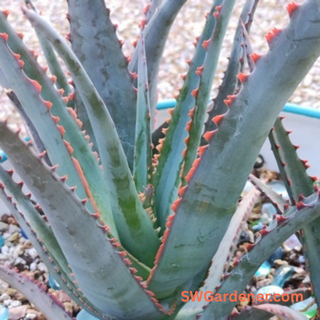With blue-green leaves lined with distinctive red margins, aloe ‘Diablo’ is an eye-catcher. ‘Diablo’ means devil, but this plant is friendlier than it sounds, since the “teeth” are fleshy rather than sharp. Here’s how to grow this cultivar of a Madagascar native.

Aloe ‘Diablo’ (Aloe divaricata ‘Diablo’) is a stunning succulent that makes a dramatic statement in any garden. Its thick, blue-green leaves are lined with contrasting scarlet red teeth. When backlit by the sun, it positively glows.
But in spite of the wicked-sounding name, this plant poses no threat. It’s non-toxic, and the teeth are rubbery rather than sharp.
In late winter, it sends up a showy 3-foot flower stalk covered with tubular red flowers that hummingbirds, bees, and butterflies love.
Why I Like This Plant
- Leaves are lined with distinctive red “teeth”
- Attractive all year long
- Colorful winter blooms
- Low maintenance
- No thorns, no litter, non-toxic
- Attracts hummingbirds, bees, butterflies
- Deer, rabbit, javelina resistant
Things to Watch Out For
If you are used to growing aloes in containers, or grow aloe vera or blue elf aloe as landscape plants, the size of aloe ‘Diablo’ can come as a shock. It can ultimately grow up to 8 feet tall!
I debated about growing this because of its potential mature size, but I’m currently growing several in pots and have one in the ground. So far, I see no sign that they are turning into “devil plants” and are staying a manageable size.
Optimal Growing Conditions
If you’re thinking of adding an aloe ‘Diablo’ to your garden, you need to find a suitable place that will keep your plant healthy and looking good… while minimizing maintenance for you.
Here are the key factors to keep in mind.
Temperature
Aloe ‘Diablo’ should be grown in USDA Hardiness Zones 9 – 11. It tolerates summer heat, especially if grown in part shade, and is cold tolerant down to 25℉.
Sun Exposure
Like most aloes, ‘Diablo’ will grow in any sun exposure from full sun to full shade, but bright, indirect sunlight or dappled shade is best. Too much sun can scorch the leaves.
Size and Growth Rate
Aloe ‘Diablo’ can ultimately reach a mature size of 6 to 8 feet tall by 3 to 4 feet wide. But since it’s slow growing, it can take years to get this big. When in bloom, flower stalks can add 3 feet in height.

Soil
Aloe ‘Diablo’ will grow in any native desert soil, but prefers sandy, well-draining soil.
If you grow one in a container, use specifically formulated cactus soil.
Other Location Considerations
This aloe is unarmed and non-toxic, so you can feel comfortable growing it where it might come in contact with pets and people.
Because it is low-litter, it is a good choice for planting near a pool.
An ideal spot for growing aloe ‘Diablo’ is under a tree, which will provide both dappled shade and cold protection.

Aloe ‘Diablo’:
The Essentials
| Common Name | Aloe ‘Diablo’ |
| Scientific Name | Aloe divaricata ‘Diablo’ |
| Origin | Madagascar (cultivar) |
| Plant Type | Evergreen succulent |
| USDA Zones | Zones 9 – 11 |
| Cold Hardiness | To 25℉ |
| Flower Color | Red |
| Flower Season | Winter |
| Mature Size | 6-8′ high x 3-4’ wide |
| Growth Rate | Slow |
| Sun Tolerance | Full, part sun |
| Water Needs | Low |
| Pests & Diseases | Root rot if overwatered |
| Garden Friendly | No thorns, no litter, non-toxic |
| Wildlife | Attracts hummingbirds, bees, butterflies Critter resistant |
How to Plant
Dig a hole as deep as and twice as wide as the nursery container. It’s generally recommended that you not add any soft fill, gravel, or fertilizer, just native soil. So if you know your soil is slow draining, amend with coarse sand or small gravel until you have a loose, well-drained mix.
When to Plant
Most landscape succulents (cactus, agave, etc.) should be planted in the spring, but winter-blooming aloes are an exception. They do most of their growing in the winter and establish best when planted in early fall.
How to Care for Aloe ‘Diablo’
Whether you’ve recently planted an aloe ‘Diablo’ or have an existing plant in your yard, here’s how to take care of it to keep it healthy and looking its best.
How to Water
You’re probably used to giving a plant a good soaking immediately after transplanting, but that isn’t the best practice with aloes and other succulents. Counterintuitively, it’s best to not water aloes for one to two weeks after planting.
Then, water twice per month spring through fall. Always allow the soil to dry out between waterings.
No supplemental water is needed during the winter, provided there have been winter rains. And, as with all succulents, skip watering when freezing temperatures are expected.
Should You Fertilize?
There is no need to fertilize aloes growing in the ground. They get all they need from the surrounding desert soil. But if you grow one in a pot, fertilize it lightly a few times a year when it’s actively growing.
Pruning & Propagation
Aloes don’t need pruning, but you can remove dead or damaged leaves any time you see them.
You’ll probably want to remove spent flower stalks after they’re done blooming.
Aloe ‘Diablo’ propagates by sending up new offsets called pups. You can separate the pups from the parent plant once they’re big enough to have some roots and use them to start new plants.
Don’t Confuse Aloe ‘Diablo’ With…
There are hundreds of aloe species, but the one you’re most likely to encounter is Aloe vera, well-known as “medicinal aloe.”
It’s important not to get them confused, since medicinal aloe is used both internally and externally as a natural remedy, particularly for treating skin conditions.
While aloe ‘Diablo’ is not toxic, it does not have the same beneficial properties as aloe vera so you should not be applying it to your skin or taking it internally.
Plant Lover Facts
Aloe ‘Diablo’ (Aloe divaricata ‘Diablo’) is a cultivar of Aloe divaricata, a native of Madagascar. The parent plant is grown as both a landscape and container plant, too, but is not common.
The cultivar name ‘Diablo’ means “devil” in Spanish. Its species name divaricata means “spread out” in Latin, referring to the branches of its flowering inflorescences.
The genus Aloe has over 500 species. When you see an aloe, you can know for sure it’s not native to the desert southwest, since all aloes are native to the eastern hemisphere.
Did you enjoy this article?
Sign up for our weekly newsletter
where you’ll find more great info on creating &
maintaining a beautiful, carefree desert landscape.
Author Bio
Deane Alban is the creator of Southwest Gardener. She is a science writer with a bachelor’s degree in botany from the University of South Florida. Gardening is her lifelong passion. She’s been gardening in Tucson for over 15 years.

